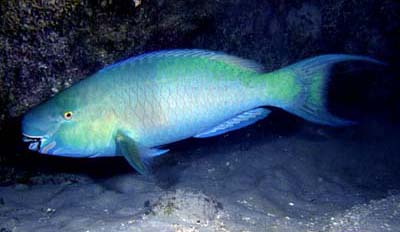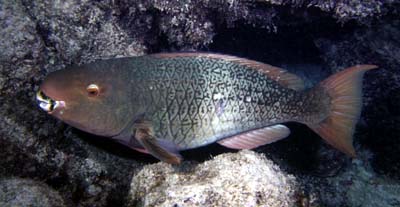
terminal male

initial phase
Scarus rubroviolaceus
The largest of all Hawaiian parrotfishes, these are common inside the reef at Hanauma, sometimes entering water barely deep enough to cover their backs. When they feed, a Saddle or Christmas Wrasse often follows to nab small creatures dislodged by the grazing giant. Terminal males are light green (darker in front, lighter in back) with a lyre-shape tail fin and a green beak (which often has a "mustache" of dark algae growing on it). The squarish humped snout of large specimens is distinctive. Initial-phase adults are brownish red in front, yellowish gray in back, with numerous short black lines at odd angles on the sides, creating a textured appearance. They may become entirely pale. Their beaks are reddish to white, also with a "mustache." Both initial and terminal-phases may display a subtle or distinct bicolor pattern, front half dark, back half light. The common name refers to the initial-phase, which alone has red coloration around the mouth. The Hawaiian name for the initial phase means "loose bowels parrotfish" (anyone who has seen a parrotfish eject sand from its anus knows why); the word `ele`ele, applied to terminal males, means "black, dark, the black color of Hawaiian eyes." Why this is so is not clear, as their coloration is light. To 28 in. Indo-Pacific and Eastern Pacific. Photos: (above) terminal male; (below) initial phase.